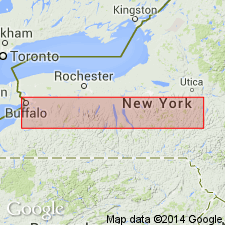
- Usage in publication:
-
- Bridgewater member
- Modifications:
-
- Original reference
- Biostratigraphic dating
- Dominant lithology:
-
- Shale
- AAPG geologic province:
-
- Appalachian basin
Summary:
Pg. 133, 219, etc. Bridgewater member of Marcellus formation. The shale overlying Chittenango member of Marcellus formation and underlying Solsville member of Marcellus in Chenango and Unadilla Valleys, [central eastern New York]. Lower part is soft, fissile, slightly arenaceous shale especially characterized by LEIORHYNCHUS LIMITARE, CONULARIA, and STYLIOLINA FISSURELLA. The succeeding zone is coarser nonlaminated shale containing LEIORHYNCHUS LAURA associated with many typical Hamilton fossils, showing the change in faunal facies to east. No continuous sequence of this member is exposed in Unadilla Valley, so that a number of ravines must be visited in order to construct a complete section. The lower part, including transition with Chittenango, is shown in Wordens Gulf 1.25 miles west of West Winfield; the middle of section is exposed in gully behind the buildings of Rose Farm 0.75 mile north of West Winfield; and the upper part, and its contact with Solsville member, are exposed in Seabridge Farm 2.25 miles west of Bridgewater. Markham and Fork Mountains at Unadilla Forks are almost completely composed of Bridgewater shale, the Solsville being also top of these elevations. Thickness 200 to 360 +/-feet. Age is Middle Devonian.
Source: US geologic names lexicon (USGS Bull. 896, p. 265).
For more information, please contact Nancy Stamm, Geologic Names Committee Secretary.
Asterisk (*) indicates published by U.S. Geological Survey authors.
"No current usage" (†) implies that a name has been abandoned or has fallen into disuse. Former usage and, if known, replacement name given in parentheses ( ).
Slash (/) indicates name conflicts with nomenclatural guidelines (CSN, 1933; ACSN, 1961, 1970; NACSN, 1983, 2005, 2021). May be explained within brackets ([ ]).

